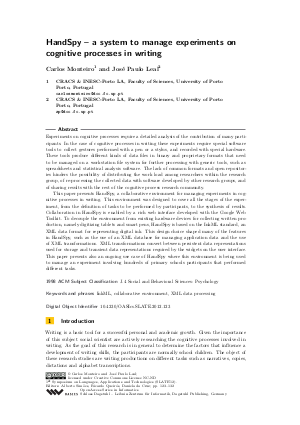HandSpy - a system to manage experiments on cognitive processes in writing
Authors Carlos Monteiro, José Paulo Leal
-
Part of:
Volume:
1st Symposium on Languages, Applications and Technologies (SLATE 2012)
Part of: Series: Open Access Series in Informatics (OASIcs)
Part of: Conference: Symposium on Languages, Applications and Technologies (SLATE) - License:
 Creative Commons Attribution-NonCommercial-NoDerivs 3.0 Unported license
Creative Commons Attribution-NonCommercial-NoDerivs 3.0 Unported license
- Publication Date: 2012-06-21
File

PDF
OASIcs.SLATE.2012.123.pdf
- Filesize: 0.54 MB
- 10 pages
Document Identifiers
Subject Classification
Keywords
- InkML
- collaborative environment
- XML data processing
Metrics
- Access Statistics
-
Total Accesses (updated on a weekly basis)
0Document
0Metadata
Abstract
Experiments on cognitive processes require a detailed analysis of the contribution of many participants. In the case of cognitive processes in writing these experiments require special software tools to collect gestures performed with a pen or a stylus, and recorded with special hardware. These tools produce different kinds of data files in binary and proprietary formats that need to be managed on a workstation file system for further processing with generic tools, such as spreadsheets and statistical analysis software. The lack of common formats and open repositories hinders the possibility of distributing the work load among researchers within the research group, of re-processing the collected data with software developed by other research groups, and of sharing results with the rest of the cognitive process research community. This paper presents HandSpy, a collaborative environment for managing experiments in cognitive processes in writing. This environment was designed to cover all the stages of the experiment, from the definition of tasks to be performed by participants, to the synthesis of results. Collaboration in HandSpy is enabled by a rich web interface developed with the Google Web Toolkit. To decouple the environment from existing hardware devices for collecting written production, namely digitizing tablets and smart pens, HandSpy is based on the InkML standard, an XML data format for representing digital ink. This design choice shaped many of the features in HandSpy, such as the use of an XML database for managing application data and the use of XML transformations. XML transformations convert between persistent data representations used for storage and transient data representations required by the widgets on the user interface. This paper presents also an ongoing use case of HandSpy where this environment is being used to manage an experiment involving hundreds of primary schools participants that performed different tasks.
Cite As Get BibTex
Carlos Monteiro and José Paulo Leal. HandSpy - a system to manage experiments on cognitive processes in writing. In 1st Symposium on Languages, Applications and Technologies. Open Access Series in Informatics (OASIcs), Volume 21, pp. 123-132, Schloss Dagstuhl – Leibniz-Zentrum für Informatik (2012)
https://doi.org/10.4230/OASIcs.SLATE.2012.123
BibTex
@InProceedings{monteiro_et_al:OASIcs.SLATE.2012.123,
author = {Monteiro, Carlos and Leal, Jos\'{e} Paulo},
title = {{HandSpy - a system to manage experiments on cognitive processes in writing}},
booktitle = {1st Symposium on Languages, Applications and Technologies},
pages = {123--132},
series = {Open Access Series in Informatics (OASIcs)},
ISBN = {978-3-939897-40-8},
ISSN = {2190-6807},
year = {2012},
volume = {21},
editor = {Sim\~{o}es, Alberto and Queir\'{o}s, Ricardo and da Cruz, Daniela},
publisher = {Schloss Dagstuhl -- Leibniz-Zentrum f{\"u}r Informatik},
address = {Dagstuhl, Germany},
URL = {https://drops.dagstuhl.de/entities/document/10.4230/OASIcs.SLATE.2012.123},
URN = {urn:nbn:de:0030-drops-35180},
doi = {10.4230/OASIcs.SLATE.2012.123},
annote = {Keywords: InkML, collaborative environment, XML data processing}
}
